2010 Bloom Season
The 2010 Alexandrium forecast for the Gulf of Maine was not borne out by cruise observations and shellfish toxicity measurements. We predicted a large regional bloom in the WGOM that did not happen. Toxicity along the coast has been low, and cruise data show very few cells in the region from Massachusetts and Cape Cod Bays to mid-coast Maine.
Two possible (and potentially related ) reasons for the absence of the bloom in the WGOM are evident thus far: 1) there was a water mass change that lies outside the envelope of observations from at least the last six years, which were the basis of the ensemble forecast that led to the 2010 prediction; and 2) along-coast surface transport off southern Maine was slower than normal.
The deep basins of the Gulf of Maine were warmer than was observed in 2003 - 2008. This water mass anomaly affects intermediate and surface waters where Alexandrium resides. In fact, surface waters were several degrees warmer than in 2008, when a large Alexandrium bloom took place. Stratification, nutrient concentrations, grazers, and other factors critical to Alexandrium growth could all have beenaffected. Our GOMTOX cruise data are being used to assess these factors.
Should we be able to deduce the mechanisms responsible for the lack of a bloom in the WGOM in 2010, those processes could then be included in the population dynamics model. Furthermore, we note that the water mass changes mentioned above relate to the larger scale circulation of the northwest Atlantic, and therefore are observable months in advance of the Alexandrium season. Therefore, it is conceivable that forecasts can be made taking into account this type of variability. It is indeed fortunate that GOMTOX cruises were scheduled for 2010, as this will allow us to understand the factors that prevented a bloom and thereby allow us to improve our model.
2010 Status Reports
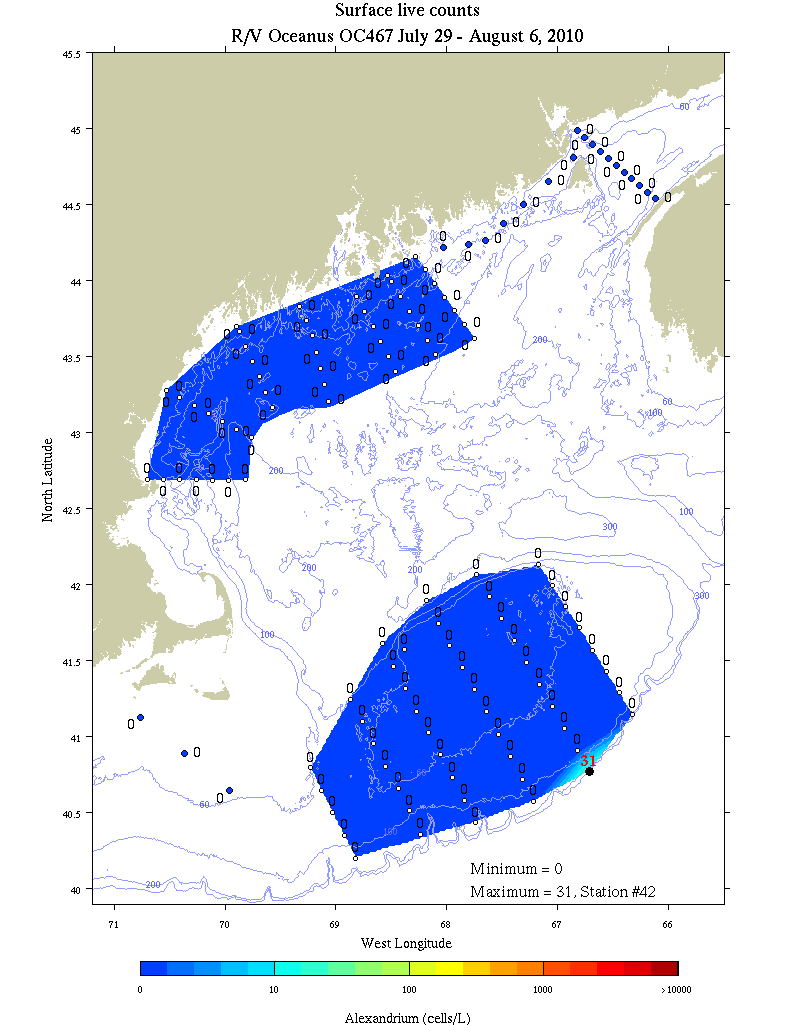
Alexandrium surface live counts. R/V Oceanus 467, July 29 - August 6, 2010. (WHOI / D. Anderson & D. McGillicuddy laboratories)
Hello All,
The OC467 coastal survey consisted of a series of transects spanning from Cape Ann to Mt. Desert Island with an additional transect in the Bay of Fundy (see map). Live counts indicate surface waters are virtually devoid of Alexandrium cells. Thus, from the point of view of documenting bloom termination, OC467 was a success. However, we must be careful not to over-interpret these surface data; a complete analysis will require thorough scrutiny of the subsurface samples.
Our ETA at WHOI is 10:00AM Friday.
Best Wishes,
Dennis
-on behalf of the OC467 science party
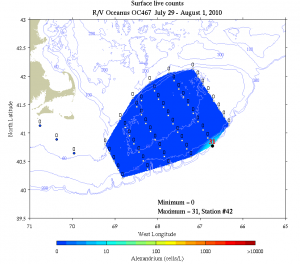
Alexandrium surface live counts. R/V Oceanus 467, July 29 - August 1, 2010
(WHOI / D. Anderson and D. McGillicuddy laboratories)
Hello All,
Earlier today we finished our survey of Georges Bank (see map). Surface waters are virtually devoid of Alexandrium cells, with a non-zero finding at only one station. During the survey we occupied a pump station at the FDA shellfish monitoring site on Cultivator Shoal, despite a live count of zero in that location. Given the near-absence of Alexandrium on the bank, we decided not to occupy the final transect of the survey on the Northeast Peak in order to leave more time for our coastal survey. We are currently in transit westward to commence the coastal survey at the Cape Ann line.
As we leave Georges Bank for the final time during GOMTOX, we have been reflecting on what has been learned thus far. Data from this cruise suggest that termination of the Georges Bank Alexandrium bloom in 2010 took place at approximately the same time as in 2008—- and both years exhibit what appears to be a seasonal bloom from May to August. Moreover, some clues to the striking interannual variability are beginning to emerge. Water mass analysis suggests that the times when Alexandrium was most abundant on Georges Bank (May, June 2007; June 2008), the water was relatively cold and salty. In contrast, low Alexandrium abundance was characterized by waters that were relatively warm and fresh. These warm and fresh anomalies have at least two potential origins. The drastic decline of the Alexandrium population from June to July 2008 was accompanied by a warm and fresh anomaly that was confined to near-surface waters, and analysis of the climatological mean temperature and salinity fields suggest an origin in the western Gulf of Maine. In 2010, a warm/fresh anomaly was present at depth on Georges Bank, as well as in the deep basins of the Gulf of Maine.
To first order, the GOMTOX findings are consistent with a “leaky incubator” model for Alexandrium populations on Georges Bank. When Georges Bank is relatively isolated from its surroundings (cold and salty), Alexandrium populations thrive. When large volumes of warm and fresh waters flow onto Georges Bank, two factors potentially hinder Alexandrium populations: (1) dilution of the Georges Bank population with low-Alexandrium water, and (2) inoculation with relatively low-nutrient water that is unfavorable for Alexandrium growth. We will see if this straw-man conceptual model holds up to further scrutiny when the full data sets are in hand.
In the meantime, its off to the coastal Gulf of Maine!
Best Wishes,
Dennis
On behalf of the OC467 Science Party
Hello All,
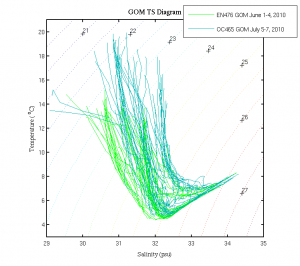
Temperature / salinity characteristics of hydrographic profiles during EN476 (light green) and OC465, both in 2010 (dark green). Note that these results must be treated with caution as the EN476 salinities have not yet been calibrated with salt bottle data yet. (WHOI / D. McGillicuddy)
The OC465 coastal survey consisted of a series of transects spanning from just south of Boston to one off Isle au Haut (see map). Surface live counts revealed two population centers of Alexandrium with concentrations in excess of 1000 cells per liter: one southwest of Penobscot Bay, and the other northeast of Cape Ann. These two areas are divided by consistently low concentrations in all but the outermost station of the Casco Bay line—an aspect that we find curious. In any case, the overall resurgence of the western Gulf of Maine Alexandrium population came as quite a surprise, given very low concentrations observed during OC460 (May 1-10) and EN476 (May 26-June 4). We had attributed the unexpectedly low concentrations to a warm and fresh water mass anomaly. Lo and behold, OC465 hydrography reveals the water mass anomaly has lessened, with intermediate and shallower waters having become saltier in the month since our last cruise (see figure). We are very eager to learn if the nutrient environment has also shifted, and how that may have affected vegetative growth of Alexandrium. Data from Dave Townsend’s lab will provide insight into that aspect. In any case, it appears that retreat of the water mass anomaly allowed the Alexandrium population in the western Gulf of Maine to re-establish itself. Another potentially related factor is advection by the coastal current. Initial returns from drifters deployed off Casco Bay suggest the along-coast velocities may have increased from their earlier sluggish state, facilitating increased transport of Alexandrium populations into the western Gulf of Maine.
Ironically, after two months of overpredictions, the forecast model is now underpredicting cell concentrations in the western Gulf of Maine. Clearly this is the year of surprises in the western Gulf!
Best Wishes,
Dennis
-on behalf of the OC465 science party

Alexandrium surface live counts. R/V Oceanus 465, June 30 - July 8, 2010 (WHOI / D. Anderson & D. McGillicuddy laboratories)
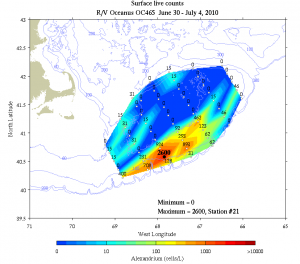
Alexandrium surface live counts. R/V Oceanus 465, June 30 - July 4, 2010 (WHOI / D. Anderson & D. McGillicuddy laboratories)
Hello All,
Earlier today we finished our survey of Georges Bank (see map). A broad swath of cell concentrations in excess of 100 cells per liter occurred along the western two-thirds of the southern flank, peaking at 2600 cells per liter. Elsewhere on the bank, cell concentrations were low. Bruce Keafer, Kerry Norton, and Chrissy Petitpas noted planozygotes in the live counts, suggesting the bloom may have reached its peak.
During the survey we occupied a pump station at the FDA shellfish monitoring site on Cultivator Shoal, despite a live count of zero in that location. A pump station was also occupied at the shelf edge, southwest of Oceanographers Canyon, where the live count was 708 cells per liter.
We are currently in transit westward to commence our coastal survey.
Best Wishes,
Dennis
On behalf of the OC465 Science Party
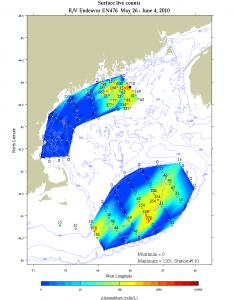
Alexandrium surface live counts. R/V Endeavor 476, May 26 - June 4, 2010 (WHOI / D. Anderson & D. McGillicuddy laboratories)
Hello All,
The EN476 coastal survey consisted of a series of transects spanning from just south of Boston to one off Mount Desert Island (see map). Surface live counts revealed low Alexandrium abundance south and west of Penobscot Bay, with cell concentrations at or below the limit of detection in that area. From Penobscot Bay to the east, cell concentrations are patchy, ranging from zero to 1201 cells per liter.
It is clear that model predictions of a larger-than-usual bloom in the western Gulf of Maine (WGOM) have not materialized thus far. We are currently investigating the causes of low Alexandrium abundance in the WGOM observed on OC460 and EN476. At this point it appears that hydrodynamic factors may have played a role, as two of the three surface drifters deployed off Casco Bay on OC460 have shown very modest along-shore transport in the month since their release on May 7 (see drifter figure). In addition, there is a distinct water mass anomaly in the deep and intermediate waters of the Gulf of Maine as compared with the major bloom that took place in 2008 (see GOM TS diagram). Deep waters are more than one degree warmer, and Maine Intermediate Waters are a few tenths of a degree warmer and a few tenths of a psu fresher than during this same time period in 2008. We are very eager to learn if there is a nutrient anomaly associated with the water mass anomaly, and how its near surface expression may have affected vegetative growth of Alexandrium. Dave Townsend’s lab will begin running the nutrient samples in the near future.
Best Wishes,
Dennis
-on behalf of the EN476 science party
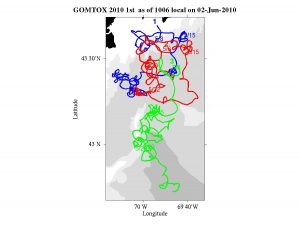
Status of drifters deployed off Casco Bay, as of June 2, 2010 (J. Manning / NMFS)
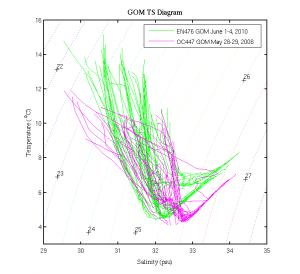
Temperature / salinity characteristics of hydrographic profiles during OC447 in 2008 (magenta) and EN476 in 2010 (green). Note that these results must be treated with caution as the EN476 salinities have not yet been calibrated with salt bottle data yet.
(WHOI / D. McGillicuddy)

Alexandrium surface live counts. R/V Endeavor 476, May 26 - June 4, 2010 (WHOI / D. Anderson & D. McGillicuddy laboratories)
Hello All,
Earlier today we finished our survey of Georges Bank (see map). The peak cell concentration of 878 cells per liter occurred on the southeastern tip of Nantucket Shoals. A broad swath of several hundred cells per liter straddled the 60m isobath on the southern flank, in the vicinity of the tidal mixing front. Elsewhere cell concentrations were low.
During the survey we occupied a pump station at the FDA shellfish monitoring site on Cultivator Shoal, despite a live count of zero in that location. Tonight we are targeting another pump station within the patch of cells on the southern flank. After that we will transit to the offshore end of the Boston line and commence our coastal survey.
Best Wishes,
Dennis
On behalf of the EN476 Science Party
A large scale cyst mapping survey conducted in late 2009 revealed very high abundance of Alexandrium resting cysts in the Gulf of Maine (see map). The cysts were not only more numerous, but also extended further to the southwest then has been observed in the past. As we have done in 2008 and 2009, we used this new cyst map as the basis of a forecast using the Alexandrium population dynamics model. Using weather and oceanographic conditions from each of the 6 preceding years (2004 - 2009) an ensemble forecast was obtained that indicated that with all of these diverse weather patterns, a major regional Alexandrium bloom would have occurred. Accordingly, a seasonal forecast for 2010 was issued calling for a significant regional event.
As of this writing (May 21), the regional bloom remains relatively limited in scale, as evidenced by data from the first GOMTOX cruise and state shellfish toxicity measurements. A few areas in western Maine have been closed, but most of the rest of the coasts of Maine, New Hampshire and Massachusetts remain open. It would appear that despite the very high abundance of Alexandrium cysts, conditions have not been optimal for growth and delivery of cells to shore. In the latter context, weather patterns for the last month have generally had upwelling favorable winds. Typically it takes several northeast storms during this interval to cause a significant coastal outbreak.
It is still early in the bloom season, so its too soon to say much about what may happen going forward. When the season is over, we will be examining the weather patterns and hydrography carefully to see if we can discern why this bloom has started slowly despite a large potential inoculum and environmental conditions (at least on land) that have led to early blooming of many flowers, trees and other plants.
As this year's bloom develops, information and observations will be posted here. Summaries from our GOMTOX research cruises may be found under the "2010 Field Observations" section.

Alexandrium surface live counts. R/V Oceanus 460, May 1 - 10, 2010 (WHOI / D. Anderson and D. McGillicuddy laboratories)
Hello All,
The OC460 coastal survey consisted of a series of transects spanning from just south of Boston to one near Bar Harbor (see map). Surface live counts revealed low Alexandrium abundance south and west of Penobscot Bay, with cell concentrations at or below the limit of detection in that area. From Penobscot Bay to the east, cell concentrations are patchy, but higher overall—with values ranging from zero to 578 cells per liter.
We are presently steaming toward home, but will take the opportunity to occupy a pump station near Minots Light on the Boston line. Given the observation of low levels of toxicity present in Massachusetts Bay earlier this season, and the low concentrations of cells in the water column, it will be of interest to determine the degree to which toxins are present in the grazer community. Microscopic examination of the live count samples revealed abundant tintinnids in that region.
Depending on time constraints, we may also be able to occupy a few more stations in Cape Cod Bay before entering the canal at 0500 Monday. ETA at WHOI is 0900.
Best Wishes,
Dennis McGillicuddy
-on behalf of the OC460 science party

Alexandrium surface live counts. R/V Oceanus 460, May 1 - 10, 2010 (WHOI / D. Anderson and D. McGillicuddy laboratories)
Hello All,
Earlier today we completed our sampling of Georges Bank. Surface live counts indicate very low Alexandrium concentrations over the entire bank, with most samples coming up zero. The only systematic pattern in the data is on the northern edge of the bank, where concentrations are consistently low, although they are at the limit of detection.
In transit between eastern Georges Bank and the western Gulf of Maine, we took the opportunity to conduct a pump profile at the FDA shellfish time-series site located on Cultivator Shoal.
Sampling of the coastal waters in Mass Bay and the western Gulf of Maine will commence shortly after midnight tonight.
Best Wishes,
Dennis McGillicuddy
-on behalf of the OC460 science party
